
Reconstructing Memory: Ouyang Chun’s ‘The Mortals’ at ShanghART Gallery
A conversation with Ouyang Chun about his work, career and latest exhibition in Shanghai…Discover this artist and his way with found objects, click HERE
A conversation with Ouyang Chun about his work, career and latest exhibition in Shanghai…Discover this artist and his way with found objects, click HERE

Forever Young: Three Chinese Artists in Manhattan - reviews of exhibitions by SHANG YANG, LIAO GUOHE and ZHANG XIAOGANG. Plus a booklaunch and a Guggenheim show. Find it all HERE on the ART LIFE

I Don't Know the Mandate of Heaven
Song Dong admits that at the age of 50 he's not sure about this 'Mandate of Heaven' business.But the work at Shanghai's Rockbund Art Museum is nothing short of extraordinary. Click HERE to read the review.
Song Dong admits that at the age of 50 he's not sure about this 'Mandate of Heaven' business.But the work at Shanghai's Rockbund Art Museum is nothing short of extraordinary. Click HERE to read the review.

Ink Remixed
Why is ink so important in China? Why does it still matter so much, even today? Why is it political - and controversial? A few of the complex reasons that make the phenomenon of "Contemporary Ink" such contested territory can be found in this review of Ink Remix, curated by Sophie McIntyre and featuring artists from Mainland China, Taiwan and Hong Kong. Read more HERE.
Why is ink so important in China? Why does it still matter so much, even today? Why is it political - and controversial? A few of the complex reasons that make the phenomenon of "Contemporary Ink" such contested territory can be found in this review of Ink Remix, curated by Sophie McIntyre and featuring artists from Mainland China, Taiwan and Hong Kong. Read more HERE.

Kaboom! Exploding reality with new media!
What's happening in video and new media in China?
Click HERE for a review of exhibitions by three important artists: Yang Fudong, Tao Hui and Yuan Guang-ming.
What's happening in video and new media in China?
Click HERE for a review of exhibitions by three important artists: Yang Fudong, Tao Hui and Yuan Guang-ming.

'Go East' - works from the Gene and Brian Sherman Collection
To title an exhibition of contemporary Asian art ‘Go East’ might seem deliberately provocative, given the geographical reality that Asia is not, in fact, to our east. It hints at Orientalism, at ‘Otherness’, at post-colonialism, as curator Suhanya Raffel acknowledges in her excellent catalogue essay. To read more Click HERE!
To title an exhibition of contemporary Asian art ‘Go East’ might seem deliberately provocative, given the geographical reality that Asia is not, in fact, to our east. It hints at Orientalism, at ‘Otherness’, at post-colonialism, as curator Suhanya Raffel acknowledges in her excellent catalogue essay. To read more Click HERE!
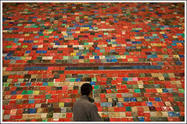
A Sea of Red - Yang Zhichao's 'Chinese Diary'
Can 3000 personal diaries collected from antique and junk markets be an artwork? Just ask Yang Zhichao! Although his previous works include having tufts of grass surgically inserted into his back, and mysterious objects inserted under his skin, this installation is meditative, evocative, nostalgic and very beautiful! Find out why a Sydney taxi driver, an immigrant from China, couldn't bear to go and see this work. Click HERE to read more.
Can 3000 personal diaries collected from antique and junk markets be an artwork? Just ask Yang Zhichao! Although his previous works include having tufts of grass surgically inserted into his back, and mysterious objects inserted under his skin, this installation is meditative, evocative, nostalgic and very beautiful! Find out why a Sydney taxi driver, an immigrant from China, couldn't bear to go and see this work. Click HERE to read more.
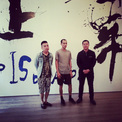
Calligraphy, Tea, Shopping and Soccer: The Yangjiang Group In Sydney
Six Soccer Teams playing three simultaneous games on a field littered with pages from Marx's 'Das Kapital' written out in Chinese calligraphy? Check. A daily tea ceremony in the gallery? Check. An event at the Chinese Gardens involving face painting and 'After Dinner Shu Fa (Calligraphy)? Check. It must be the anarchic Zheng Guogu and the Yangjiang Group!
Click HERE to read the review of the exhibition at Sydney's 4A Centre for Contemporary Asian Art.
Six Soccer Teams playing three simultaneous games on a field littered with pages from Marx's 'Das Kapital' written out in Chinese calligraphy? Check. A daily tea ceremony in the gallery? Check. An event at the Chinese Gardens involving face painting and 'After Dinner Shu Fa (Calligraphy)? Check. It must be the anarchic Zheng Guogu and the Yangjiang Group!
Click HERE to read the review of the exhibition at Sydney's 4A Centre for Contemporary Asian Art.
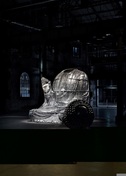
A Buddha of Ash
A Buddha made of ash from the burned prayers of the faithful takes shape in Sydney's Carriageworks. Click HERE for the article about Zhang Huan's departure from violent forms of bodily performance art and his re-shaping of sculptural traditions, creating impermanent structures of spiritual significance. The ephemeral nature of the work implies many things: the collective memory, the soul, and also “the collective ineffectiveness arising from taking action when none should be taken, upsetting the natural order of things,” says the artist.
A Buddha made of ash from the burned prayers of the faithful takes shape in Sydney's Carriageworks. Click HERE for the article about Zhang Huan's departure from violent forms of bodily performance art and his re-shaping of sculptural traditions, creating impermanent structures of spiritual significance. The ephemeral nature of the work implies many things: the collective memory, the soul, and also “the collective ineffectiveness arising from taking action when none should be taken, upsetting the natural order of things,” says the artist.
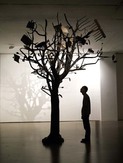
COMMUNE at the White Rabbit
From earnest Utopianism to grim, state-enforced collectivism; from familial relationships and networks to our connection with the natural world—all of these possible associations are present in the new show at Sydney’s White Rabbit Gallery of Contemporary Chinese Art. From Judith Neilson’s impressive collection, curator Bonnie Hudson has selected works by twenty-three artists. They include representatives of the older generation that emerged in the 1980s and ’90s, characterized by transgressive experimentation and a merging of the local and global in their practice, through to young (in some cases, very young) artists whose work reflects their experiences growing up in the “new China.” Find out more: Click HERE to read the rest of the review, published on Dailyserving in September
From earnest Utopianism to grim, state-enforced collectivism; from familial relationships and networks to our connection with the natural world—all of these possible associations are present in the new show at Sydney’s White Rabbit Gallery of Contemporary Chinese Art. From Judith Neilson’s impressive collection, curator Bonnie Hudson has selected works by twenty-three artists. They include representatives of the older generation that emerged in the 1980s and ’90s, characterized by transgressive experimentation and a merging of the local and global in their practice, through to young (in some cases, very young) artists whose work reflects their experiences growing up in the “new China.” Find out more: Click HERE to read the rest of the review, published on Dailyserving in September

Cloaks of Invisibility: Liu Bolin in New York
How can an artist make himself invisible? And how is this erasure a metaphor about the ills of our contemporary world. Liu Bolin is sometimes called "The Invisible Man." Click HERE to read a review of his most recent exhibition, at Klein Sun Gallery in New York.
How can an artist make himself invisible? And how is this erasure a metaphor about the ills of our contemporary world. Liu Bolin is sometimes called "The Invisible Man." Click HERE to read a review of his most recent exhibition, at Klein Sun Gallery in New York.

Home and Away - Two Taiwanese Artists at SCAF
The word “home” has elusive, slippery connotations. In Chinese, the character “jia” (家) also means “family.” It suggests notions of sanctuary, shelter, belonging. But for some the meanings are more complicated. For the marginalized, the outsiders, the lost ones in our midst, it reminds them of all that is missing. For others, in a world crisscrossed by a diaspora of dislocated people seeking safety and security, “home” is a fragile memory. HOME is an exhibition of works by Taiwanese artists, Chien-chi Chang and Chen Chieh-jen, that explores this complex and nuanced territory. Entering Sydney’s Sherman Contemporary Art Foundation, you encounter a darkened and almost silent space filled with minimalist wheeled “wagons,” cabin-like boxes made of recycled timbers from construction sites. The very materials are redolent of memory, the passage of time, the transformation of one kind of world to another. Read more: Home and Away at SCAF
The word “home” has elusive, slippery connotations. In Chinese, the character “jia” (家) also means “family.” It suggests notions of sanctuary, shelter, belonging. But for some the meanings are more complicated. For the marginalized, the outsiders, the lost ones in our midst, it reminds them of all that is missing. For others, in a world crisscrossed by a diaspora of dislocated people seeking safety and security, “home” is a fragile memory. HOME is an exhibition of works by Taiwanese artists, Chien-chi Chang and Chen Chieh-jen, that explores this complex and nuanced territory. Entering Sydney’s Sherman Contemporary Art Foundation, you encounter a darkened and almost silent space filled with minimalist wheeled “wagons,” cabin-like boxes made of recycled timbers from construction sites. The very materials are redolent of memory, the passage of time, the transformation of one kind of world to another. Read more: Home and Away at SCAF

The Art of Spectacle
Over the past three decades art in China has become increasingly audacious, extravagant and iconoclastic. Exposure to Western Modernism and Postmodernism in the 1980s gave artists the tools and freedom to merge traditional themes with fresh ideas for a new form of national innovation. The following Beijing exhibitions, which I saw during April 2014, characterise this exciting moment in Chinese contemporary art. From Xu Zhen's startling installations, to painter Xie Qi's versions of Chinese banknotes, to a room filled with earth at Pace Beijing...what could possibly connect these diverse experiences? Read on to find out more at The Culture Trip
Over the past three decades art in China has become increasingly audacious, extravagant and iconoclastic. Exposure to Western Modernism and Postmodernism in the 1980s gave artists the tools and freedom to merge traditional themes with fresh ideas for a new form of national innovation. The following Beijing exhibitions, which I saw during April 2014, characterise this exciting moment in Chinese contemporary art. From Xu Zhen's startling installations, to painter Xie Qi's versions of Chinese banknotes, to a room filled with earth at Pace Beijing...what could possibly connect these diverse experiences? Read on to find out more at The Culture Trip

China Syndrome - six exhibitions in Beijing
Beijing is exhausting, exhilarating, infuriating, and wonderful, all at the same time. The energy of the city, undefeated by its weight of imperial and revolutionary history, or by the dead hand of contemporary politics and power, is encapsulated in the lively diversity of its art scene. In the late 1990s and the early years of this century, Chinese artists were rock stars, earning big money fast. International galleries opened palatial premises. Today things are not quite so upbeat, but there is sti optimism about China itself, and about the role of art and artists in this fast-mutating society.
Originally published on May 5 2014 on Daily Serving. Read on by clicking the link below:
http://dailyserving.com/2014/05/china-syndrome-six-exhibitions-in-beijing/#more-43762
Beijing is exhausting, exhilarating, infuriating, and wonderful, all at the same time. The energy of the city, undefeated by its weight of imperial and revolutionary history, or by the dead hand of contemporary politics and power, is encapsulated in the lively diversity of its art scene. In the late 1990s and the early years of this century, Chinese artists were rock stars, earning big money fast. International galleries opened palatial premises. Today things are not quite so upbeat, but there is sti optimism about China itself, and about the role of art and artists in this fast-mutating society.
Originally published on May 5 2014 on Daily Serving. Read on by clicking the link below:
http://dailyserving.com/2014/05/china-syndrome-six-exhibitions-in-beijing/#more-43762
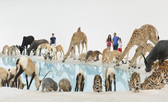
Our Place In The Universe: Cai Guo-qiang
In ‘Heritage’, 99 animals, predators and prey alike, stand with bent heads in a peaceful coexistence, an allegory of utopian harmony. Sculpture as spectacle.
Click on the link below to read the rest of the article:
Originally published in The Art Life, January 2014:
http://theartlife.com.au/2014/our-place-in-the-universe/
In ‘Heritage’, 99 animals, predators and prey alike, stand with bent heads in a peaceful coexistence, an allegory of utopian harmony. Sculpture as spectacle.
Click on the link below to read the rest of the article:
Originally published in The Art Life, January 2014:
http://theartlife.com.au/2014/our-place-in-the-universe/
